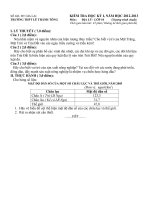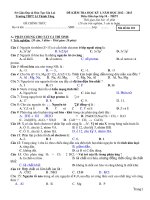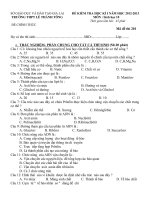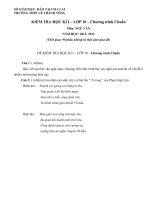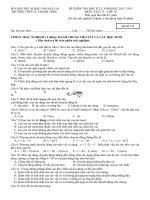Sensors and actuators , LE THANH PHUC
Bạn đang xem bản rút gọn của tài liệu. Xem và tải ngay bản đầy đủ của tài liệu tại đây (1.89 MB, 46 trang )
SENSORS AND ACTUATORS
Le Thanh Phuc
Faculty of Automotive Engineering
University of Technical Education Ho Chi Minh City
Email:
Introduction
•
In any control system, sensors provide measurements of important plant variables in a format suitable for the digital
microcontroller.
•
•
Actuators are electrically operated devices that regulate inputs to the plant that directly controls its output.
Modern automotive electronic control systems use microcontrollers based on microprocessors to implement almost
all control functions. Each of these subsystems requires one or more sensors and actuators in order to operate.
2
3
Magnetic Reluctance Position Sensor
•
This sensor consists of a permanent magnet with a coil of wire wound around it. A steel disk that is mounted on the
crankshaft (usually in front of the engine) has tabs that pass between the pole pieces of this magnet.
4
•
The magnetic field in a material is described by a pair of field quantities that can be compared to the voltage and
current of an ordinary electric circuit.
•
•
One of these quantities is called the magnetic field intensity vector H. It exerts a force analogous to voltage.
The response of the magnetic circuit to the magnetic field intensity is described by the second vector, which is called
magnetic flux density vector B, which is analogous to current. In these two quantities.
5
Reluctance Method
•
The reluctance method begins with Ampere’s law in integral
where ampere-turns NI are assumed given, and magnetic field intensity H and magnetic flux density B are to be found. The closed-line integral is
replaced by a summation
where the closed path consists of line segments of subscript k, each of which is in the direction of the field intensity. Thus the direction of the field and flux is
assumed known. Because flux density B prefers to flow through high-permeability materials, the line segments (straight or curved) are assumed to follow a
path through high-permeability materials such as steel. If the steel has a gap made of air, the closed path follows the shortest part of the airgap.
6
7
8
9
10
11
12
13
14
15
16
17
18
19
20
21
SPEED SENSORS BASED ON FARADAY’S LAW
22
23
24
25


